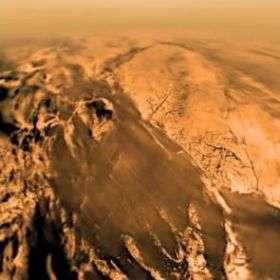December 22, 2009 weblog
Titan's lakes could be explored by boat

(PhysOrg.com) -- If a suggestion to be made to NASA comes to fruition, vast lakes thought to be filled with liquid hydrocarbons near the north pole of Saturn's moon Titan, may one day be explored by boat.
A scientific team led by Dr Ellen Stofan from Proxemy Research in Washington DC in the US, has been studying the concept for around two years, and is now ready to submit a proposal to NASA.
The proposal is for a future mission to explore the Ligeia Mare and/or the Kraken Mare in the north of Titan by boat. Both lakes are huge, with Kraken Mare being bigger than the Caspian sea, the largest lake on Earth. If the mission eventuates, they would be the first lakes to be explored outside of Earth.
Evidence of the existence of dark patches thought to be lakes on Titan was first found by the Cassini mission in 2005, with Kraken Mare being discovered in 2007. Many dark areas were observed to have channels leading into them, and the contours of the channels imply they were created by liquid flowing into or out of the lakes. Methane and other hydrocarbons are stable liquids in Titan's frigid conditions (where the temperature can be as low as -179C), but water is not, so scientists interpreted the dark areas as lakes of liquid methane, ethane, or a mixture of the two.
The proposal is to launch the mission, dubbed the Titan Mare Explorer (TiME) in January 2016, and to make flybys of Earth and then Jupiter to pick up the required gravitational energy to reach Saturn's moon. It would arrive on Titan in June 2023. The estimated cost of the mission is less than $425 million, which is quite low in comparison to many space exploration missions, such as the $3.2 billion Cassini-Huygens mission launched in 2004.
The boat would carry a mass spectrometer, sonar, cameras and meteorology instruments. The main objective of the proposed mission is to analyze the lakes to determine their precise chemical composition, but a secondary objective is to study the cycling of methane and other hydrocarbons to work out how these systems operate. Sonar would be carried to check the depths of the lakes and the bottom contours, and the cameras would send images back to Earth.
Titan resembles Earth in that there seems to be a circulation of liquid between the land, water bodies, and the atmosphere. On Earth this is the hydrologic cycle. In Titan's case the liquid is not water but would probably behave in the same way. The cycle has been dubbed the methane-ologic cycle. According to Stofan's team, studying the shared climate processes on Titan could help us better understand climate processes on Earth, since if we could develop models that work on both Earth and Titan, we would be more certain we understand the fundamentals for Earth.
NASA and ESA (the European Space Agency) are considering a joint mission to Jupiter, but have no immediate plans to visit Saturn. There may be an opportunity for the Titan mission under NASA's Discovery Class program, for which bids open early in 2010.
Dr Stofan, who is also honorary professor at University College London, described the proposal at the American Geophysical Union annual meeting of Earth scientists held in San Francisco from December 14 to 18 this year.
© 2009 PhysOrg.com



















